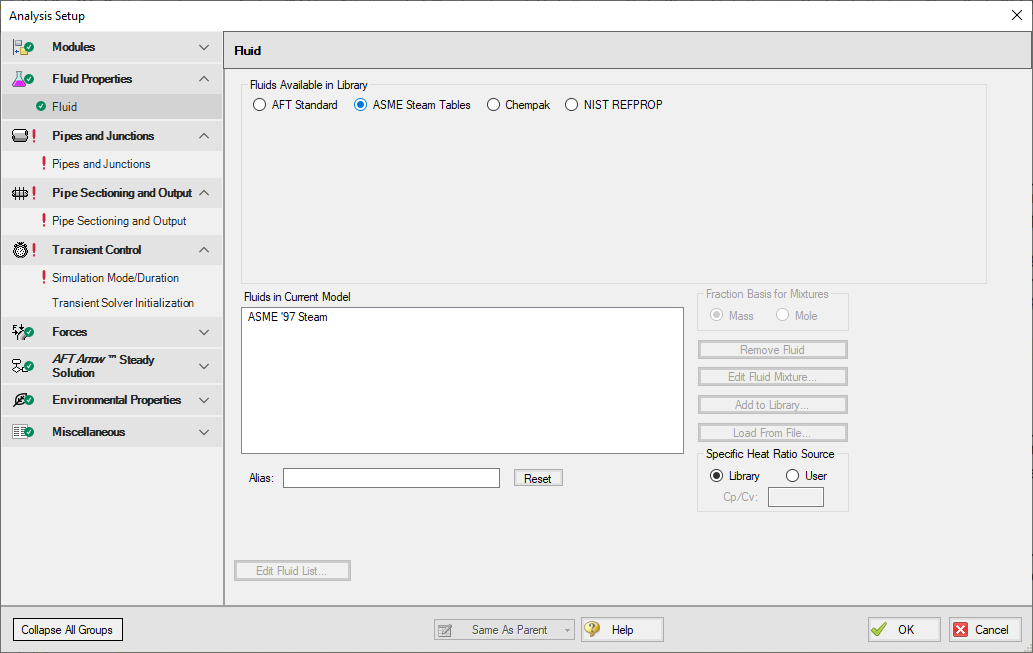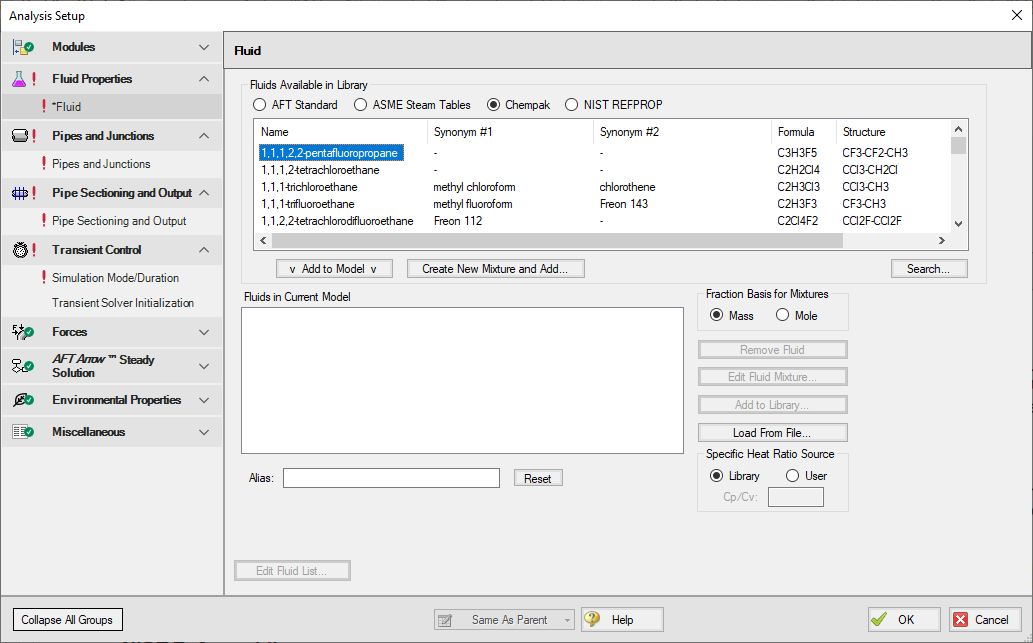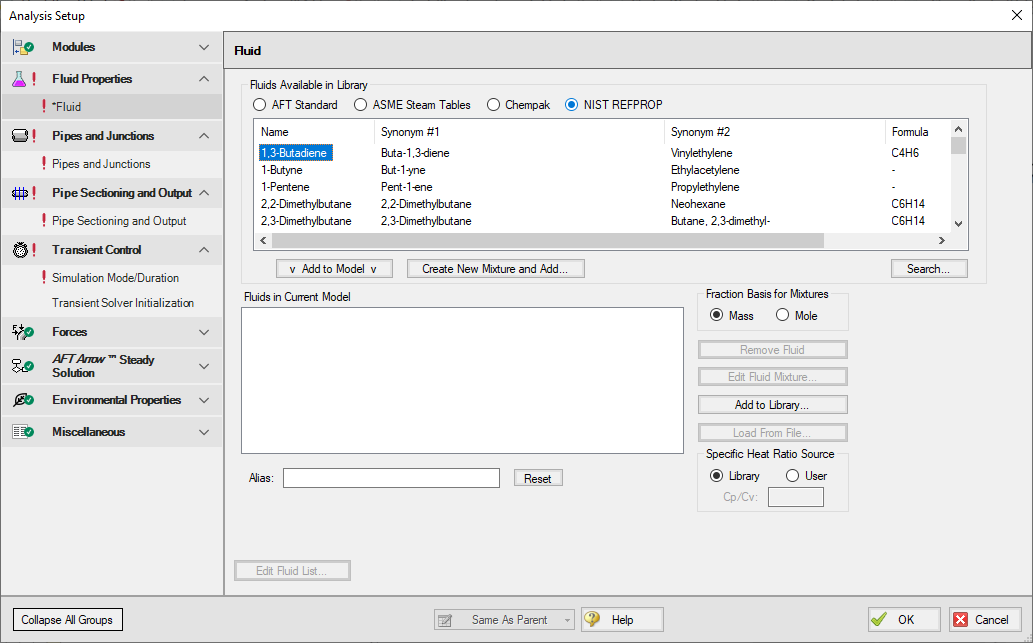Fluid Panel
The Fluid panel in the Analysis Setup window gives you control over the fluid properties that influence your pipe system analysis. A default fluid is not selected - one must be defined to run any simulation.
The first selection that must be made is what Fluids library to use.
The available Fluid libraries are:
-
AFT Standard - An included library that offers 30 common fluids to the user. Saturation line data was added for AFT Standard fluids in xStream 2.
-
ASME Steam/Water- Data from the 1997 ASME Steam Tables.
-
NIST REFPROP - Data compiled by the National Institute of Standards and Technology (NIST) using thermophysical property models for a wide variety of fluids. User defined mixtures of these fluids can be defined. For more info see the following sources: REFPROP FAQ, NIST Chemistry WebBook, and NIST Chemical Name Search.
-
Chempak Fluid - A large library of fluids with detailed property information. User defined mixtures of these fluids can be defined. See the Chempak Detailed Discussion for more information.
After selecting a library, the Fluids Available in Library list is populated. One of the fluids can be selected and used with the Add To Model button.
When determining which fluid package is most appropriate, it is recommended that you consult the table below to ensure your selection suits your needs.
Table 1: Compatibility Chart for Fluid library Selection
| Fluid Library | Model Requirements | |||||
| Mixtures | Condensation Data | System Troubleshooting | Final Runs | Complex Systems* | User Specified Fluids | |
| AFT Standard | P | P** | P | P | ||
| NIST REFPROP | P | P | P | P | P | |
| Chempak | P | P | P | P | P | |
| ASME Steam | P | P | ||||
* Evaluating the complexity of a system is most easily done in early runs of the model. It is suggested that all early runs should be run with an AFT Standard fluid (even if the real system fluid is a mixture), and the run-time recorded. This runtime should inform your decision on which fluid library is needed to run the more polished runs when high accuracy results are needed. Run times can vary significantly between the 4 libraries, so make sure you evaluate your time constraints and accuracy needs when weighing this decision. Factors that can impact the run time include the ratio in the length of the smallest pipe to the largest pipe, presence of mixtures, usage of Junctions containing graphs, and the presence of sonic choking.
** It is strongly recommended that all runs used to troubleshoot the design of the system model are run using AFT Standard.
AFT Standard Fluid Library
The AFT Standard fluid library offers multiple fluids for easy use in AFT xStream models. Density and enthalpy can be evaluated for these fluids using any of six equation of state models and three enthalpy models to account for both temperature and pressure dependence.
Transport properties for the AFT Standard fluids (specific heat, dynamic viscosity and thermal conductivity) and Saturation Pressure are assumed to be functions of temperature only using polynomial curve fits. This assumption is generally reasonable below the fluid's critical point, although systems at very high pressure usually start to show some pressure dependence.
To add a fluid into your model, select it from the Fluids Available in Library list and click the Add to Model button. The fluid will appear in the Fluids in Current Model area. Once the fluid is added, specify the temperature in the Fluid Properties area on the right to calculate values of density, dynamic viscosity, and vapor pressure, as shown in Figure 1.

Figure 1: The Fluid panel in the Analysis Setup window with AFT Standard library selected
ASME Steam Tables
The ASME Steam Tables Library offers users access to water and steam properties obtained from the IAPWS Industrial Formulation 1997 for the Thermodynamic Properties Steam (ISPWS-IF97ASME Press, ASME International Steam Tables for Industrial Use (CRTD-Vol. 58), published by the American Society of Mechanical Engineers, Three Park Avenue, New York, NY 10016).
After selecting ASME Steam/Water, "ASME '97 Steam" is automatically added to in the Fluids in Current Model area as shown in Figure 2.
Detailed fluid properties information from SteamCalc can be calculated using the AFT SteamCalc Viewer, which can be accessed from Tools > Fluid Property Viewers > SteamCalc. The SteamCalc Viewer will be launched as a separate application, which can then be used to calculate fluid properties at various conditions.
For more information on AFT SteamCalc Viewer see the SteamCalc Help file.

Figure 2: Fluid Panel in Analysis Setup with ASME Steam library selected
Chempak Library
The optional add-on Chempak Data offers approximately 700 fluids to the user. In addition, it offers non-reacting mixture calculations.
A Chempak fluid is added the same way as an AFT Standard fluid is added. To add a Chempak fluid, select Chempak Fluid from the Fluid panel in the Analysis Setup window. From here, select the appropriate fluid from the library and click the Add to Model button. After a fluid is added to the model, it will appear in the lower list under Fluids in Current Model.
Information on the theory and calculation methods used in Chempak is given in the Chempak technical information topic.
Detailed fluid properties information from Chempak can be calculated using the AFT Chempak Viewer, which can be accessed from Tools > Fluid Property Viewers > Chempak. The Chempak Viewer will be launched as a separate application, which can then be used to calculate fluid properties at various conditions. A Chempak Data license is required to use the Chempak viewer.
For more information on AFT Chempak Viewer see the Chempak Viewer Help File.

Figure 3: Fluid Panel in Analysis Setup with Chempak library selected
NIST Refprop Library
The NIST REFPROP Library offers users access to fluid properties from Version 10 of the NIST Reference Fluid Thermodynamic and Transport Properties Library.
Add a fluid from the Fluids Available in Library list by selecting it and clicking Add to Model, as shown in Figure 3.
Fluids from the NIST REFPROP library support fluid mixtures.

Figure 3: Fluid Panel in Analysis Setup with NIST Refprop selected
Related Blogs



